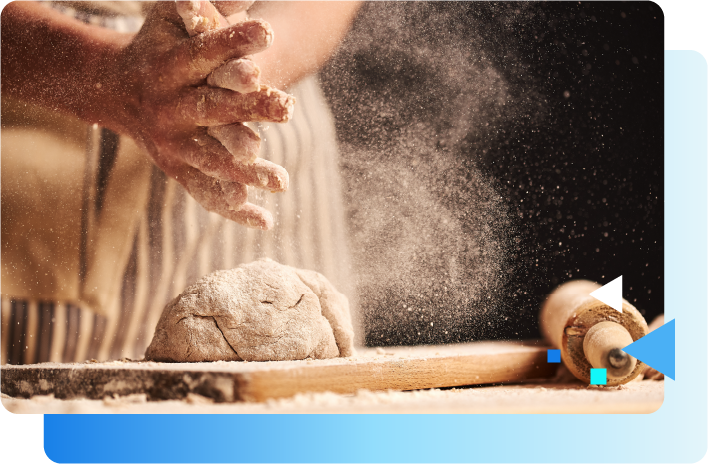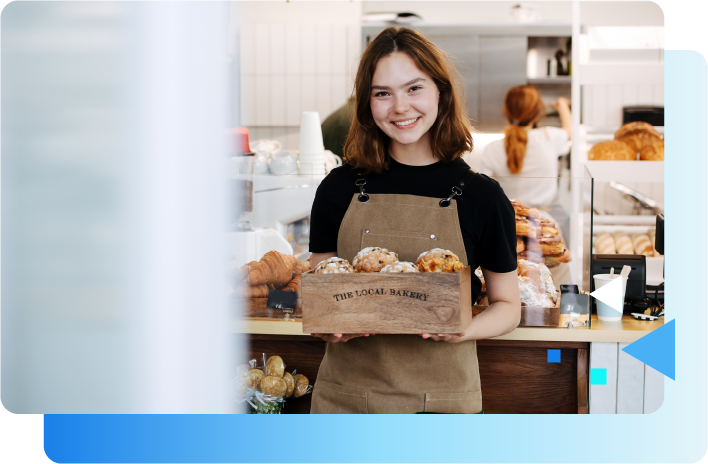Create a food blog or website
Launch your food blog
Showcase your culinary world, share tasty recipes and attract food-loving readers with our flexible and scalable platform.
From £1.89 ex. VAT/month

Why create a food blog?
Build a community
Share your culinary discoveries with a community of enthusiasts and get inspired by others: a food blog can be a place for rewarding encounters and discussions.


Launch a career in cooking
A blog can also be a showcase for your recipes. It can lead to partnerships and often opens up professional opportunities in the culinary sector.
Expand your network
Discussions with communities and professionals often lead to offline meetings (events, professional engagements), which help to expand your network.


Generate additional revenue
Creating a cooking blog can also make you money. Generate additional revenue through partnerships with food and beverage brands!
Choose an all-in-one solution to build your website

Steps to creating a food blog website
- Find a impactful domain name that’s easy to remember and spell.
- Select a CMS like WordPress when you place your order
- In WordPress, select a template to set your design
- Add additional features
- Add links to your social media profiles
- Publish content regularly on your website
The different ways to monetise a food blog
Affiliate marketing
Affiliate marketing can make you money as you recommend products or services through specific links. Every time a reader buys a product via your link, you receive a commission. This method is ideal for promoting ingredients, kitchen utensils or cookbooks that you use and enjoy. By organically integrating affiliate links into your blog articles, you can generate passive income while providing added value to your readers. There are WordPress plugins designed to manage your affiliate links effectively, and optimise your website’s SEO.
Sponsored posts
Sponsored posts are simply articles written in partnership with brands. They involve presenting and promoting their products or services through your blog, in exchange for a fee. This monetisation method is ideal, as it enables you to create unique and engaging content while generating revenue. However, be sure to choose partners that match your culinary background to maintain your audience’s trust. Transparency is also a key factor. Be sure to make it clear when an article is sponsored to maintain credibility with your readers.
Donations from your readers
Donations from your readers is a direct way to monetise your blog. By offering quality content for free, you can inspire your audience to support your work through voluntary contributions. There are several platforms designed to facilitate donations, such as Patreon or Buy Me a Coffee. Encourage readers to contribute by explaining how their support helps maintain and improve the blog. This can strengthen your connection to the community and shows how much your readers appreciate your content. Also use social media and your webpage to promote these donation options and publicly thank your contributors, increasing your blog’s engagement and visibility.
Product placement
Product placement is the process of incorporating branded products into your publications, whether they are articles or videos. For example, you can include dish sets, kitchen utensils, or specific ingredients in your recipes. By integrating these products in a natural and authentic way, you can earn the trust of your readers while generating revenue. Brands pay for their products to be showcased in a real-world setting, and it can also offer your readers useful shopping ideas for their own culinary plans.
Copyrights
Launch your food blog with OVHcloud
Security
Protect your food blog with a robust and reliable infrastructure that’s monitored 24/7. Our hosting solutions include regular updates to enhance security, and offer advanced protection against DDoS attacks. Tools to back up data and restore it from up to 14 days prior are also included, and an integrated SSL certificate ensures that transactions remains secure and your visitors’ information remains confidential.


Flexibility
Is your food blog growing? Our services dynamically adapt to your needs with scalable options and easily deployable features. With WordPress included in our hosting plans, you get a flexible and expandable platform to help manage your content. Our customisable solutions support the growth of your blog, which can include specific management, marketing and SEO tools.
A comprehensive, managed solution
Our food blog hosting plans include everything you need for a worry-free launch and management: high-performance storage, email management with 10 business email addresses, databases and SSL certificates. Get a free domain name for the first year* to launch your food blog at no extra cost.

There’s an OVHcloud website for every idea
Tips and advice
How can I optimise my food blog?
To optimise a food blog, there are several plugins that are essential and offer specific features that are perfect for the needs of food bloggers.
- WP Recipe Maker: ideal for creating optimised recipe sheets.
- Yoast SEO: Helps improve SEO by providing readability analytics and tools to manage meta tags and hyperlinks.
- Sassy Social Share: offers customisable sharing buttons for the most popular social networks, making it easier to share your content.
- WP Rocket: accelerates load time by optimising cache and file compression. However, be careful not to install too many plugins, to avoid slowing down your website and causing disruption. It is also worth choosing the right hosting plan, as well as a striking domain name with an suitable extension (e.g. .blog) for your website, to ensure optimal performance and good accessibility.
How do I create an content calendar for my food blog?
A content calendar is an essential tool for planning and organising the content of your food blog. Use WordPress plugins like Editorial Calendar or CoSchedule to create and manage your calendar directly from your WordPress dashboard. Plan recipes, blog articles, and social media posts. While you do, bear in mind certain seasons, holidays and special events to create relevant and timely content. An editorial calendar helps you to stay organised, maintain a steady flow of content, and keep your readers engaged. With these tools, you can view your upcoming posts, assign tasks to contributors, and adjust your plans as needed. Incorporating marketing elements into your calendar can also be beneficial for promoting your food blog. Consider using sharing options to increase the visibility of your content on the web and attract a wider audience!
Your questions answered
How do I optimise the SEO of my food blog?
To optimise your food blog’s SEO ranking, use relevant keywords in your titles, descriptions and content. Include terms like “recipes”, “cooking” or “utensils” in a natural way. Regularly post engaging and quality content: blog posts should be well structured with clear titles and subtitles. For a more advanced strategy, consider hiring a SEO and SEA agency that can help maximise your online visibility and effectively manage your digital marketing campaigns.
How do I improve the user experience of my food blog?
Improving the UX (user experience) of your food blog is essential for retaining visitors. For example, make sure your website is mobile-friendly, as many users access blogs via their smartphones, and optimise page loading speeds by compressing images. You can also add interactive features like forms, a space for comments, or options for sharing on social media. A good UX can therefore encourage visitors to come back regularly, increasing your blog’s traffic and improving your online visibility.
What kind of content should I publish on my food blog?
To attract a wide audience, post a diverse range of content on your food blog. Publish detailed recipes, articles on culinary technique, product reviews, and interviews with chefs. Share high-quality photos and videos to make your articles more engaging, and include tips and tricks for beginners. You can also post articles on food trends, buying guides for cooking utensils, or personal stories related to your own cooking experiences. In short, high-quality and varied content will increase your chances of retaining readers and boosting traffic to your site.
*The following extensions are included for a period of one year with any purchase of an OVHcloud web hosting plan, then renewal is charged at the annual price for the extension selected from the following list: .co.uk, .com, .shop, .store, .tech, .me .live, .space, .xyz, .online, .site, .pro, .cloud, .blog, .name, .ovh, .net, .org, .info, .eu, .fr, .re, .be, .boutique .it, .de, .pl. Not valid for extensions that include free transfer.




